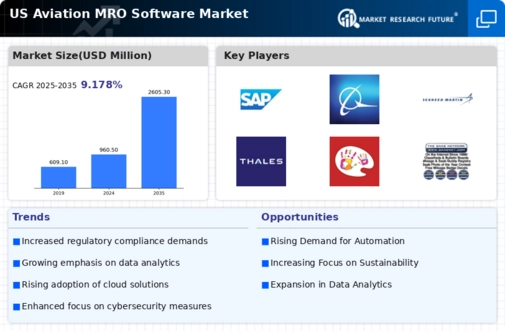The US Aviation MRO Software Market is a dynamic and rapidly evolving sector characterized by intense competition and innovation. This market comprises a broad spectrum of solutions catering to various segments of the aviation industry, including flight planning, maintenance management, safety management, and operational efficiency. The competitive landscape features several established players vying for market share while also facing emerging companies introducing cutting-edge technologies. Key factors influencing competition include technological advancements, regulatory compliance, customer service excellence, and the ability to integrate solutions seamlessly across various aviation platforms.
Companies in this market are continually striving to enhance their product offerings through strategic partnerships and collaborations, ensuring they remain at the forefront of industry developments. SAP, as a leading player in the US Aviation MRO Software Market, brings a wealth of expertise and robust functionality to its offerings. The company has established a strong presence in this sector with solutions that support management of airline operations, maintenance, and logistics. SAP leverages its extensive experience in enterprise resource planning (ERP) to optimize processes and facilitate analytics in aviation.
Its strengths lie in the ability to integrate and provide comprehensive data solutions that help organizations streamline operations, enhance decision-making capabilities, and ensure compliance with industry standards. Furthermore, SAP's investments in research and development enable the company to continuously innovate and adapt its services to meet the evolving needs of aviation stakeholders .Raytheon Technologies also plays a significant role in the US Aviation MRO Software Market, positioning itself as a key player with a diverse range of products and services. The company is well-known for its aviation software solutions focused on enhancing aircraft performance, maintenance operations, and safety management systems.
Raytheon Technologies benefits from its established market presence, well-recognized brand affiliation in the aerospace and defense sectors, and a commitment to innovation. With a track record of strategic mergers and acquisitions, the company has effectively expanded its technological capabilities and broadened its service offerings to encompass a comprehensive suite of aviation software solutions. These strengths enable Raytheon Technologies to not only maintain its competitive edge but also provide tailored services that address specific challenges faced by aviation operators in the US market.





















Leave a Comment